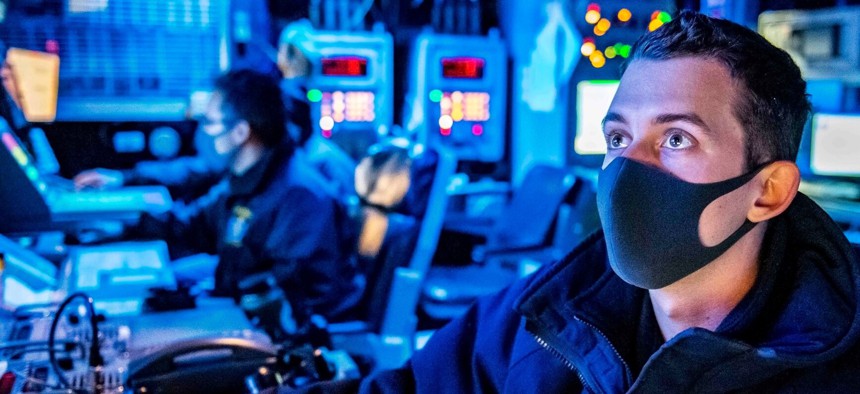
Navy Lt. Louis Petro stands watch as the tactical action officer in the combat information center aboard the USS Germantown in the East China Sea, July 17, 2020. Navy Petty Officer 2nd Class Taylor DiMartino
US Naval Services Aim to Put Network-War Concepts to Global Test
Enormous exercise will combine several new concepts in scenarios up to major combat.
For the past several years, the U.S. Navy and Marine Corps have been developing super-agile networked versions of age-old warfighting concepts. Now the services will try them out in a globe-spanning wargame that will bring together live, virtual, and computer-generated units to test the concepts in major conflict.
Postponed last summer and with its exact dates still unannounced, Large Scale Exercise 21 will be the first of a triennial series, according to Adm. Christopher Grady, the commander of U.S. Fleet Forces Command.
“Technology is revolutionizing our ability to expand the battlespace and LSE 2021 is a great opportunity to expand what it means to train at the Varsity level. We have shifted focus from the individual Carrier Strike Group to a larger Fleet-centric approach, challenging fleet commanders' abilities to make decisions at a speed and accuracy that outpaces the adversaries,” Grady said in a prepared statement.
But are the services biting off more than they can chew? LSE 21 is slated to test at least five new concepts in scenarios involving 36 live units — aircraft carriers, submarines, unmanned systems, etc. — plus more than 50 units participating virtually and an “unlimited array” of computer-generated units, according to a Fleet Forces Command statement.
“The risks with that is everyone is going to focus on sort of their small piece of this puzzle, rather than thinking about how all the disparate pieces fit together,” said Becca Wasser, a defense fellow at the Center for a New American Security. “For example, someone's got to be focusing on what it means for them to be testing this new, unmanned system, but they're really only going to be focusing on that, versus, you know, the bigger picture at play.”
That bigger picture involves testing several new concepts of operations that seek to harness the power of networks to make forces more agile, resilient, and lethal. Among them are Distributed Maritime Operations, a way to better integrate and synchronize forces and effects; Littoral Operations in a Contested Environment, a concept for fighting on- and offshore; and Expeditionary Advanced Base Operations, which governs fights that can range far inland. All depend on the Naval Operational Architecture, the integrated networks, infrastructure, data, and tools that connects those distributed forces and commands.
Most of these concepts have been tested only in isolation or in small-scale exercises. LSE 21 is the services’ first attempt to replicate, with scenarios of increasing complexity and challenge, what it would be like to use these concepts in a high-end fight against another major power.
Wasser said these concepts are meant to be used together in order to improve expeditionary operations, the survivability of the force, and to gain an advantage in a conflict with a near-peer adversary.
“While these concepts are mutually reinforcing in theory, more needs to be done to ensure they are in practice, and the Large Scale Exercise is an opportunity to see where these concepts create positive effects and where they are lacking. It is also an opportunity to identify potential areas [for] improvement, particularly for things like command and control, which undergird U.S. military operations,” she said.
The services expect about 25,000 personnel will participate across 17 time zones, six naval and Marine Component Commands, five numbered fleets, and three Marine Expeditionary Forces, the Fleet Forces statement said.
The specific units, ships, and aircraft that will participate are still being finalized, but the exercise is expected to include squadrons representing all Navy and Marine Corps airframes. One participating platform will be the Autonomous Littoral Connector surface vessel, which provides logistics support near the shore, according to Fleet Forces Command. And for this exercise, the Navy will be handling over this logistics capability to the Marine Corps to command and control.
The virtually linked and computer-generated units in the exercise will allow the Navy and Marine Corps to increase the number of exercise participants and “better replicate the realistic scale of scenarios the Navy and Marine Corps team is likely to face in the future,” the statement said.
Because this is the first year the Navy is attempting this type of exercise, it will only involve the United States, according to Lt. Cmdr. Tabitha Klingensmith, a spokeswoman for Fleet Forces Command.
“Supporting the live, virtual, constructive operating environment required for an exercise at this scale is complex. We feel it is a responsible decision to make the first iteration a U.S. only exercise, providing us an opportunity to test and evaluate the new globally-integrated format,” Klingensmith said.
While China is the “pacing threat” for the Pentagon’s current national defense strategy and the Indo-Pacific is now the region of most concern for the U.S. military, this naval exercise is meant to include challenges facing the Navy and Marine Corps around the world. Klingensmith said participating forces—whether they are on ships or on land-- will be distributed across Fleet Forces Command, U.S. Pacific Fleet, and U.S. Naval Forces Europe-Africa Command areas of operation.
“The exercise focus is not on a specific threat or region but is centered around challenging commanders to integrate globally and make and coordinate decisions that have effects across all domain boundaries. The increasingly complex and dynamic operating environments the Navy faces require an exercise design that is equally complex and dynamic,” she said in an email.




